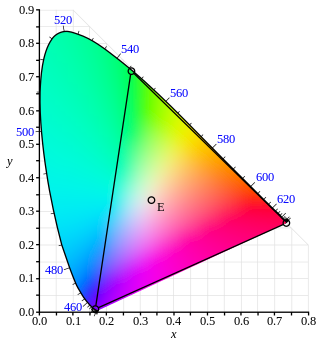
Back الفضاء اللوني سي آي إي 1931 Arabic CIE 1931 XYZ Catalan CIE XYZ Czech CIE-Normvalenzsystem German Espacio de color CIE 1931 Spanish CIE 1931 Estonian فضای رنگ سیآیایی ۱۹۳۱ Persian CIE 1931 XYZ -väriavaruus Finnish CIE XYZ French CIE 1931 XYZ Galician
This article needs additional citations for verification. (May 2019) |

In 1931 the International Commission on Illumination (CIE) published the CIE 1931 color spaces which define the relationship between the visible spectrum and human color vision.[1][2] The CIE color spaces are mathematical models that comprise a "standard observer", which is a static idealization of the color vision of a normal human. A useful application of the CIEXYZ colorspace is that a mixture of two colors in some proportion lies on the straight line between those two colors. One disadvantage is that it is not perceptually uniform. This disadvantage is remedied in subsequent color models such as CIELUV and CIELAB, but these - and modern - color models still use the CIE 1931 color spaces as a foundation.
The CIE (from the French name "Commission Internationale de l'éclairage" - International Commission on Illumination) developed and maintains many of the standards in use today relating to colorimetry. The CIE color spaces were created using data from a series of experiments, where human test subjects adjusted red, green, and blue primary colors to find a visual match to a second, pure color. The original experiments were conducted in the mid 1920s by William David Wright using ten observers[3] and John Guild using seven observers.[4] The experimental results were combined, creating the CIE RGB color space. The CIE XYZ color space was derived from CIE RGB in an effort to simplify the math.
These color spaces are fundamental tools for measuring color for industry, including inks, dyes, and paints, illumination, color imaging, etc. The CIE color spaces contributed to the development of color television, the creation of instruments for maintaining consistent color in manufacturing processes, and other methods of color management.
- ^ CIE (1932). Commission internationale de l'Eclairage proceedings, 1931. Cambridge: Cambridge University Press.
- ^ Smith, Thomas; Guild, John (1931–32). "The C.I.E. colorimetric standards and their use". Transactions of the Optical Society. 33 (3): 73–134. Bibcode:1931TrOS...33...73S. doi:10.1088/1475-4878/33/3/301.
- ^ Wright, William David (1928). "A re-determination of the trichromatic coefficients of the spectral colors". Transactions of the Optical Society. 30 (4): 141–164. doi:10.1088/1475-4878/30/4/301.
- ^ Guild, J. (1932). "The colorimetric properties of the spectrum". Philosophical Transactions of the Royal Society of London. Series A, Containing Papers of a Mathematical or Physical Character. 230 (681–693): 149–187. Bibcode:1932RSPTA.230..149G. doi:10.1098/rsta.1932.0005. JSTOR 91229.
The trichromatic coefficients for [Wright's] ten observers agreed so closely with those of the seven observers examined at the National Physical Laboratory as to indicate that both groups must give results approximating more closely to 'normal' than might have been expected from the size of either group